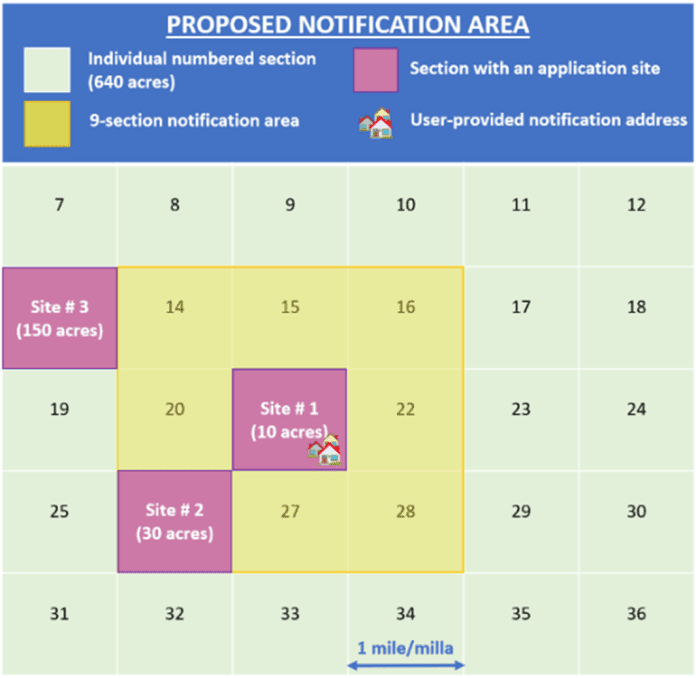
The California Department of Pesticide Regulation (CDPR) has released a proposal for their new “Pesticide Application Notification System.” While not as robust as initially feared, the proposal goes beyond reasonableness and opens the door to unwarranted activism. CDPR’s proposed system will have nine critical elements set forth as follows:
Anticipated Users: The proposed statewide system design would allow any person to search for and/or be notified about scheduled applications of certain pesticides within a particular distance of a valid California street address. The proposed design would allow users to search anonymously for scheduled applications.
Access To Notification: The proposed statewide system would provide two options for accessing information about pesticide applications. One option would allow users to anonymously enter a valid California address through a web-based platform to access notifications of applications. The other option would allow users to subscribe to automatically receive notification messages by providing any valid California address and either a phone number or email address to receive the notification.
Pesticides Included in the Notification System: The proposed statewide system would notify users of all permitted restricted materials, which require a Notice of Intent (NOI). Restricted materials are pesticides that pose a higher potential risk to public health or the environment compared to other pesticides.
Notification Area: The proposed statewide notification system would pull information directly from the Notices of Intent submitted by growers as part of the permitting process for using restricted material pesticides. The standard location information submitted on all Notices of Intent is based on a statewide mapping grid system. The most specific location included in this mapping grid is a one square mile area called a section. Each section is comprised of 640 acres. A Notice of Intent specifies the section in which the application is planned to occur. For example, site #2 is a 30-acre farm located somewhere within the 640 acres of section #26. In the proposed system, users would enter any valid California street address and receive information about planned applications in the section in which the address is located and all adjacent sections. Referencing this image, the department is proposing that the public could view pesticide applications within a nine-square-mile area around the address entered. In the example provided, an application in site #3 would not trigger a notification for the address located in section #21.
Notification Delivery Time: The proposed system would provide information about approved applications of restricted material pesticides at least 24 hours prior to a scheduled application. This would require a regulatory change to ensure the 24-hour advanced notice. This regulatory change would be needed to provide sufficient time both for County Agricultural Commissioners to review Notices of Intent and for the public to receive notice of the planned application. DPR is interested in knowing whether users who subscribe for notification messages would like to receive multiple notifications per day as individual applications are approved or if a combined daily summary would be preferred.
Language: The proposed notification system would at a minimum be available in English and Spanish. DPR is exploring the feasibility of including other languages as well.
Delivery Mechanism: Internet-based options that are being considered for the delivery of notification messages to users who subscribe to automatically receive notification messages include e-mail, SMS texts or push notifications. The department is also evaluating options for notification delivery that do not require internet access.
Information Included in the Notification: A notification would include (a) the planned date of the pesticide application; (b) the location of the section where the application will occur relative to the address entered (see example in provided image); and (c) the pesticide being applied. DPR is evaluating any additional information that may be included depending on the mode of notification delivery.
User Resources: Many existing websites (including DPR’s website) provide resources, such as detailed descriptions about restricted materials or how to report a potential pesticide exposure. The department would share its existing materials and is considering what additional content or references to other websites and resources could be helpful.
Most concerning in CDPR’s proposal is that the notification is NOT limited to the only those who could be exposed by the pesticide application. We are concerned the only possible purpose for those not directly impacted by the pesticide application is to create the opportunity for activism and possibly even stop the application itself. In Monterey County, more than 60% of the people notified about fumigation applications don’t even live in California! In addition, the distance for those to be officially notified is not specified and will be debated in the workshop process. We believe the pesticide labels already provide the protection necessary as EPA and CDPR already consider exposure to bystanders and anyone else that could be exposed into consideration. This proposal goes way beyond that and is not warranted.
Workshops were held during the last week of June and CDPR is still accepting comments. We encourage anyone and everyone concerned with this proposal to weigh in and comment.

Roger A. Isom | President/CEO, Western Agricultural Processors Association
Roger is President/CEO of the California Cotton Ginners and Growers Association and Western Tree Nut Association. He brings over 30 years of regulatory and legislative advocacy experience, specializing in environmental and safety matters. Roger’s responsibilities include the management of both Associations’ staff and day-to-day operations. Roger is also the President of the Ag Energy Consumers Association (AECA), board member and Past President of the Ag One Foundation at California State University Fresno, and manages the Navel Orangeworm Action Committee (NOWAC).















